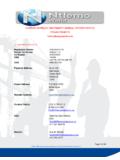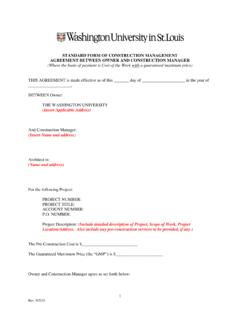Transcription of THE ARMY LEARNING MANAGEMENT SYSTEM OVERVIEW …
1 ATIS-PdM-0000327 Revision M 1 2020-04-02 THE ARMY LEARNING MANAGEMENT SYSTEM OVERVIEW PRODUCT MANAGER ARMY TRAINING INFORMATION SYSTEM (FORMERLY KNOWN AS DISTRIBUTED LEARNING SYSTEM ) 1. general . The Army LEARNING MANAGEMENT SYSTEM (ALMS) is the third component of the Army s evolutionary acquisition strategy to support Army training that is provided via Distributed LEARNING (DL). The previous efforts featured the construction and deployment of Digital Training Facilities (DTF) at Army installations worldwide and their subsequent networking and MANAGEMENT through the Army Training Information SYSTEM (ATIS) Enterprise MANAGEMENT Center (EMC), Fort Eustis, VA.
2 ATIS also fielded the Deployed Digital Training Campuses (DDTC) in support of the unit-based, individual training of deployed Forces. As the latest component, ATIS delivered the Mobile Digital Training Facility (MDTF). MDTFs are designed to be connected to the unit's local area network for use wherever and whenever access to DL is needed. 2. THE ALMS. The ALMS is the Army-approved, centrally-managed and funded SYSTEM for training MANAGEMENT . The ALMS streamlines, consolidates, and provides a centralized point of delivery to accomplish the Army s training processes. The ALMS builds upon ATIS s supporting infrastructure and utilizes Department of Defense (DoD)-managed common user networks to implement a comprehensive, automated SYSTEM for administering Army training throughout the Force.
3 As designed, the ALMS can manage a student s training activities from initial entry and continue throughout his/her service. The ALMS provides course and training resource MANAGEMENT , scheduling and registration functions, courseware distribution, delivery, and storage, and permanent record keeping of training activities and results. a. ALMS Background. The ALMS was the third increment of a four increment Distributed LEARNING Systems (DLS) product. DLS was an Acquisition Category (ACAT) IV project that supports transformation of Army training through the use of information technology (IT). DLS was developed under an evolutionary acquisi tion strategy and during FY09.
4 Functional requirements for the ALMS evolved during the late1990s under the direction and oversight of Headquarters (HQ), Army Training and Doctrine Command (TRADOC). Contract award and SYSTEM development began in 2000-2001. The SYSTEM successfully underwent a Limited User Test performed by the Army Test and Evaluation Command in June 2004 and received Full-Rate Production approval in September 2004. Working from an Army-approved, installation-based fielding list developed by TRADOC, ATIS began ALMS fielding by conducting SYSTEM user training at the Maneuver Support Center, Fort Leonard Wood, MO, in November 2004. ATIS performed a major software version upgrade for the ALMS in 2007, 2013, and 2019.
5 Under the provision of the TRADOC Capability Manager, the ALMS requirements were rebaselined in 2013 to support the version. ATIS-PdM-0000327 Revision M 2 2020-04-02 Today, DLS, now PdM ATIS, is a modernized information technology infrastructure that provides access to individual and collective training, Army Modernization Training (AMT), and self-development courses to Soldiers and units, anywhere, anytime, using multiple means and technologies. PdM ATIS supports the Army goals of improved individual and unit readiness, less disruption of Army families, standardization of training and training MANAGEMENT across the Army, and cost savings/cost avoidance for training events, while maintaining the quality of the training experience.
6 All training is provided at no cost to the individual or unit in the Active Army, Army Reserves, Army National Guard, and Department of Army Civilians. b. ALMS Fielding Status. As a fielded Army Acquisition product, the ALMS is currently in sustainment status. However, it continues to grow in utilization and functionality, as it stays current with Army training needs, and keeps pace with technical upgrades of commercial hardware and software that make up the ALMS. c. ALMS Functions. The list below reflects the major SYSTEM functions and capabilities of the ALMS: 1. Provides external data exchanges between the Army Training Requirements and Resource SYSTEM (ATRRS), and the general Fund Enterprise Business SYSTEM s (GFEBS) training support application.
7 2. Exports training completion data to the Army Career Tracker (ACT) and Digital Training MANAGEMENT SYSTEM (DTMS). 3. Accepts and processes formatted lists of students needing specified training and exports training results. 4. Accepts and processes registration and enrollment requests for content Managed by the ALMS. 5. Schedules the appropriate resources (facilities, equipment, supplies, faculty, etc.) required to conduct directed and self-motivated education/training. 6. Supports multiple training delivery types, such as Web-based, instructor-led, collaborative, and curricula that have a blend of these types. 7. Identifies scheduling conflicts in real-time on user interface.
8 8. Manages online testing, including providing a restricted testing environment. 9. Records and reports training status and results through a variety of pre-formatted reports. 10. Distributes, delivers, stores, and presents, upon request, both SCORM- conformant and other standards-compliant education and training products. 11. Enforces prerequisites and other constraints when scheduling students for instructional units or as a requirement for registration. 12. Provides access to ALMS functionality with a Web browser-based interface for all users, without the need of additional client-side applications. 13. Provides classroom Instructors with automated grade book functions for recording Learner assessment results, attendance taking, and marking lesson completions.
9 14. Manages task and certification-based curricula. ATIS-PdM-0000327 Revision M 3 2020-04-02 15. Maintains training and education records and stores content associated with completed work as a reach-back capability. 16. Collects, stores, and reports evaluation feedback from education/training personnel and students for evaluation of the quality, value, efficiency, and effectiveness of education/training resources (instructional units, tests, instructors, etc.). 17. Maintains an inventory database of education/training products, resources, and materials. The ALMS provides training MANAGEMENT functions concentrated in the area of training delivery or execution.
10 The diagram in Figure 1 shows the major ALMS functions in terms of discrete groupings of training and training MANAGEMENT activities. In this diagram, blocks colored yellow represent interfaces with external automated information MANAGEMENT systems; red represents ALMS core training support functions; and blue represents the classroom-oriented training execution experience. Figure 1. Major ALMS functions Following is a brief description of training and training MANAGEMENT activities represented in the diagram s blocks (clockwise from upper left). AKO: The ALMS uses Army Knowledge Online (AKO) for identification of users to manage user access to the SYSTEM .








